

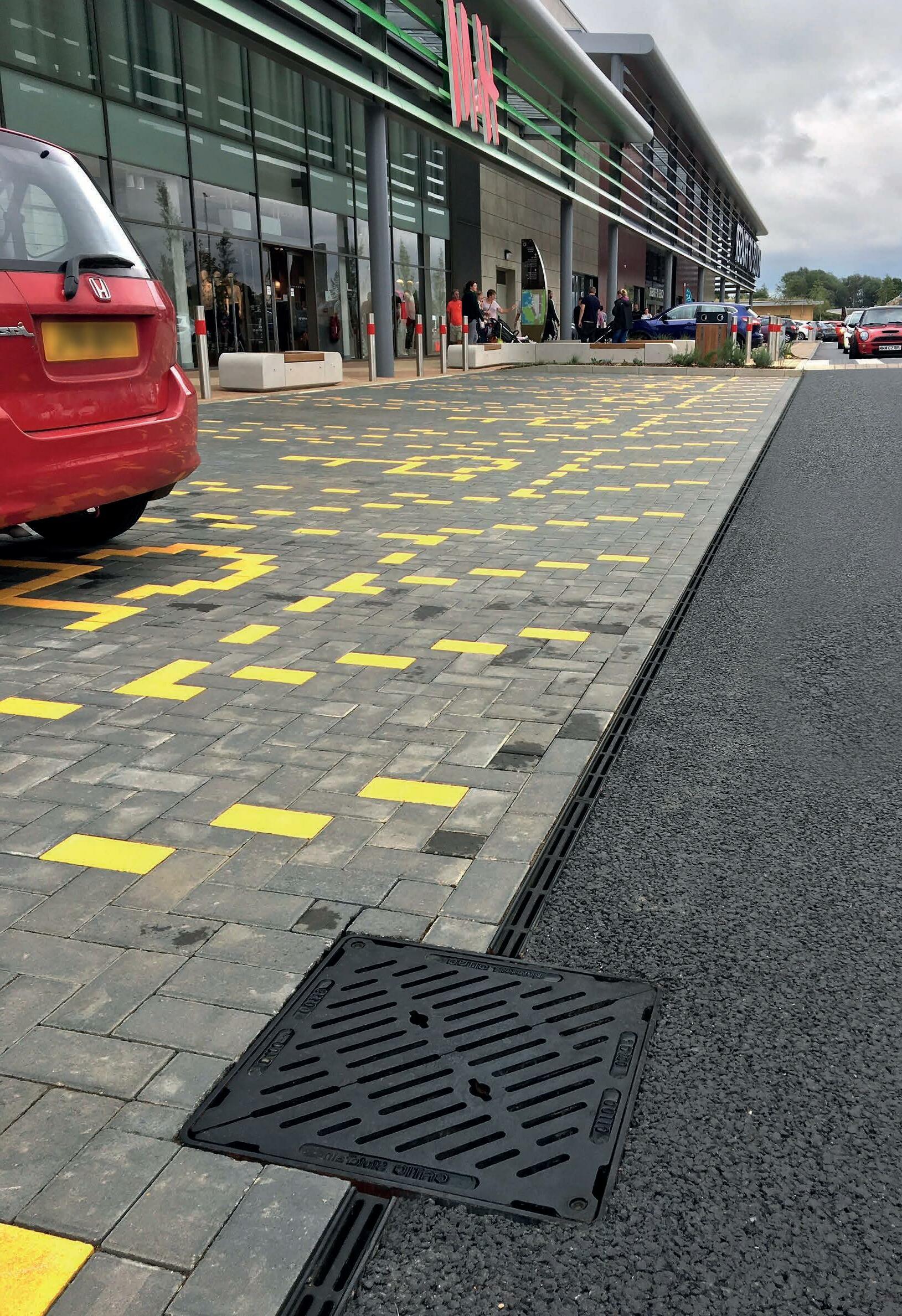
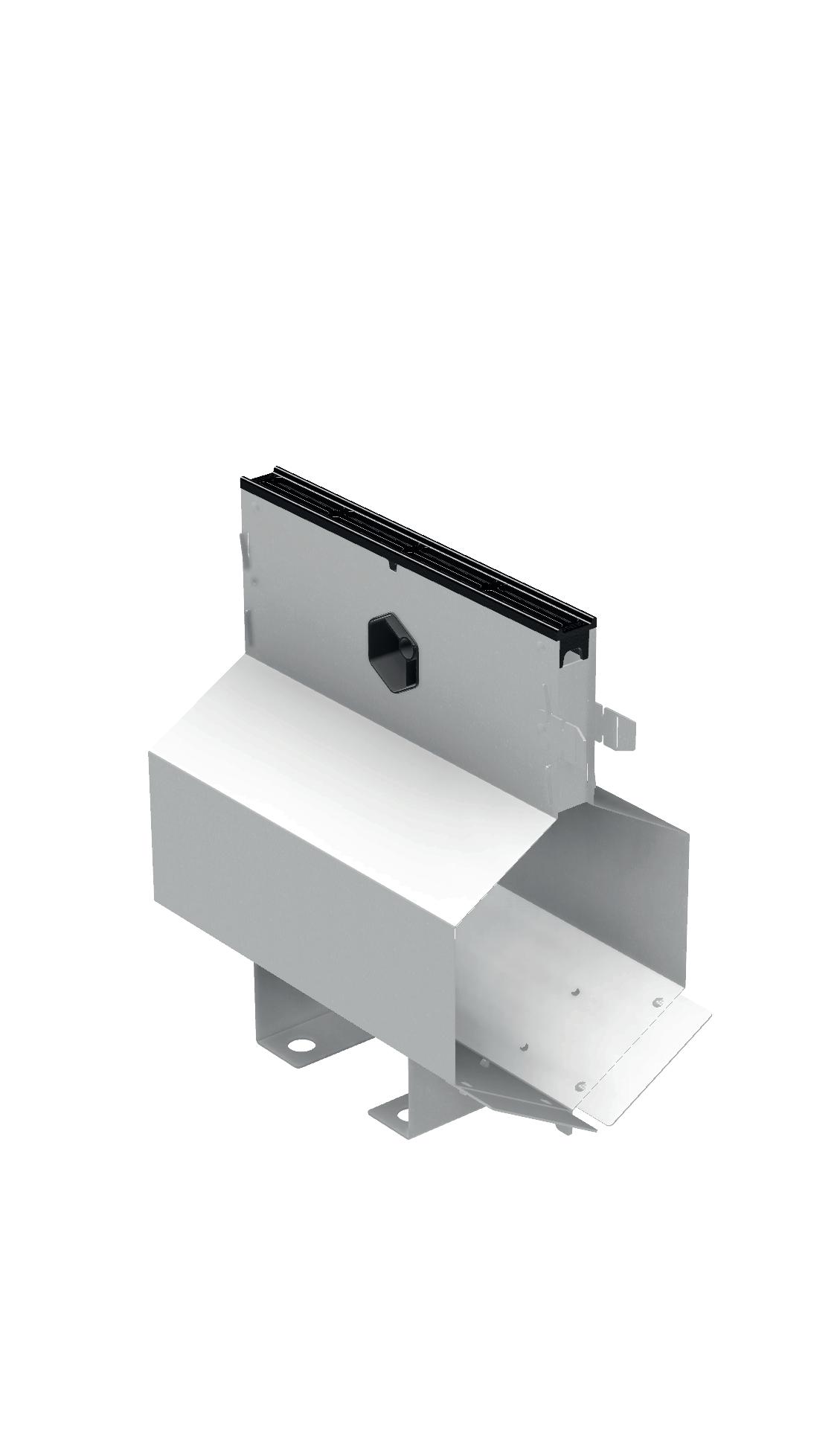






Alumasc is a UK-based supplier of premium building products. The majority of the group’s business is in the area of sustainable building products which enable customers to manage energy and water use in the built environment.
Alumasc Water Management Solutions provide ‘Rain to Drain’ solutions, that set the standard for urban water management. They include: Skyline Fascias, Soffit & Copings; Alumasc Rainwater Gutters & Downpipes; Harmer Building Drainage; Wade Building Drainage and Gatic Drainage & Engineered Access Covers.
Under the AWMS banner, customers benefit from rainwater and drainage products that capture, retain and control the flow of rainwater in the most effective way inside and outside buildings.


Channel units and accessories should be offloaded safely from the delivery vehicle by mechanical handling equipment.

As far as practically possible, channel should be installed in situ at the earliest opportunity after delivery. Channels should be stored upright on level, solid ground, in a clean and dry area away from possible site damage. Depending on the geographic location of the site, contractors should be familiar with the storage of metal building materials in the local atmosphere and environment. To protect materials from prolonged exposure to the elements caused by site conditions and/or delays below points should be considered:
Avoid the prolonged uncovered and exposed storage of channels
Do not cover with polythene sheeting that would encourage condensation


Where possible, store in a fully enclosed and ventilated building that.

We recommend that no more than two banded packs of channel are stacked securely on top of one another. Care should be taken when removing straps that hold channel units together.
Care should be taken when lifting and moving channel units and accessories, especially if these are large. Units should not be dropped, thrown or dragged, as this may cause damage. Individual unit weights may necessitate the need for mechanical lifting equipment to comply with Manual Handling Regulations.If mechanical lifting equipment is used to move Slotdrain units, to prevent possible sliding action, lifting slings or chains should be placed around the complete unit at locations that ensure the unit is restrained in a level position.
Dimensions and weights for the Slotdrain products are available from www.alumascwms.co.uk and the Drainage Product Guide.
Drawings giving comprehensive recommendations for the installation of Gatic Slotdrain are available for all channel types, sizes and surface finishes at www.gatic.com.
Each project has a unique and diverse combination of ground conditions and traffic movements that are beyond the control of Gatic. As such the Slotdrain product may be required to withstand vertical and horizontal loads outside the scope of the load class and testing criteria specified within BS EN 1433. We therefore advise that the specifying engineer departs from our standard installation details and adds reinforcement or other applicable construction details where necessary.
The adjacent surface finish and its foundation should be designed to withstand the specified service loads, and to prevent ground movement and differential settlement.
Gatic Slotdrain channels should NOT be trafficked by any vehicle (site machinery or other) until the final surface finish has been applied, and has had time to cure fully, and the installation has been completed.
If it is necessary for vehicles to cross partially-installed channel runs on site, sections of channel should ideally not be installed in those locations. If this is not possible, then adequate protection should be put in place around and on top of the exposed channel throat, taking into account the load, size and type of vehicles crossing the channel.
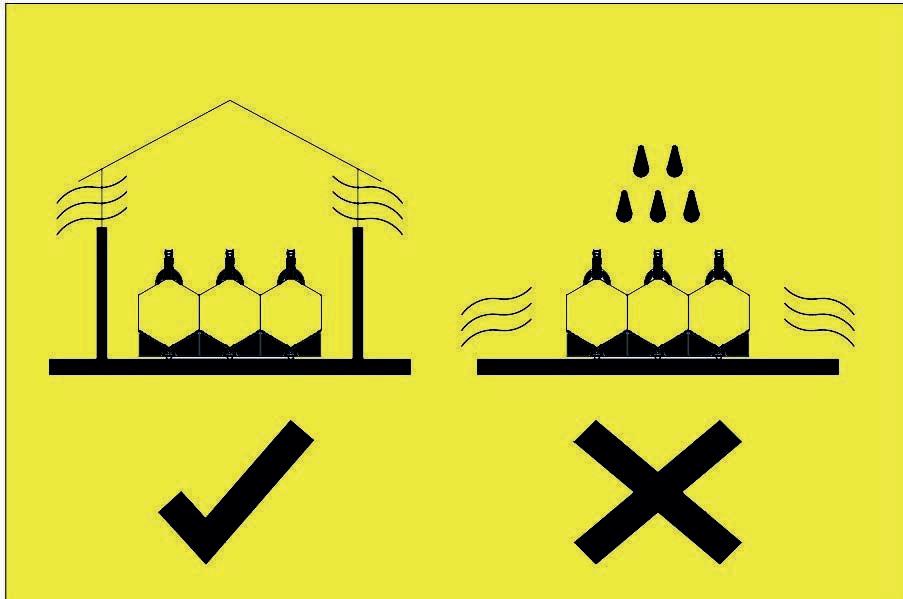

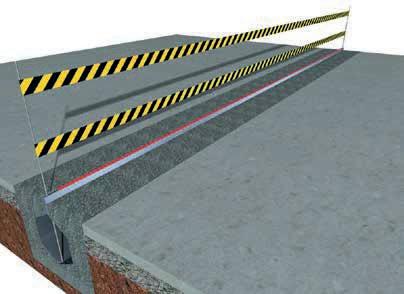
If trench excavation is required, the width and depth of the trench should take into account the following:
• Overall depth of the channel
• Overall width of the channel
• Adequate working room
• Installation of steel reinforcing
• Installation of concrete base
• Installation of ‘formwork' (see Formwork Installation Method)
• Trench supports
• Various depths of channel (‘stepped fall’ configuration)
If using a formwork method, it is recommended that a concrete base is poured into the trench, and allowed to cure before channel units are set in place. This provides a solid, level platform on which to set out and align the channel units. The solid concrete base will be unaffected by adverse weather conditions (such as rainfall), and this allows for a more precise installation.
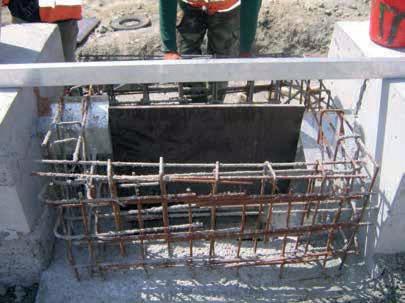
The contractor may decide to use a single width trench where a stepped fall configuration is used. For example, in a run incorporating 150mm, 225mm and 300mm channels, a uniform trench based on the 300mm channel could be used. Minimum trench depths and
The project engineer and client should decide whether Gatic boxes or chambers supplied by others (cast in-place) should be used to form access, outlet or silt collection points.

• Gatic boxes can be installed quickly and easily along with the Slotdrain system to achieve a precise, high quality finish
• Concrete chambers allow the project engineer greater flexibility regarding the size of chambers and type of cover or grating used
When constructing chambers on site, Gatic can provide Catchpit Connectors and drainage gratings to help ensure that the chambers will connect to the Slotdrain system with minimal effort.


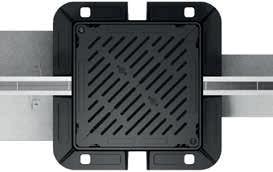

A full range of technical drawings are available providing dimensions for all box types.
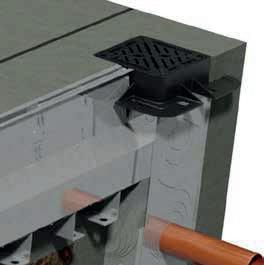
Before placing the unit in the trench:
• Remove the appropriate cut-out sections for the channels and outlet pipe to be connected. Channel types and pipe sizes are marked on all sides of each box.
• The most effective method to remove pre-formed knock-out sections in boxes is to cut the small number of joining tags with a handheld mechanical cutting tool.


• If installing an outlet unit, remove the appropriate cut-out section for the outlet pipe.
The larger boxes may weigh more than is permitted for manual handling regulations. These should be moved into position by mechanical handling equipment.
Where an outlet pipe is to be connected, it should now be put into position. The pipe should be pushed through the appropriate hole (25-40mm) The gap around the pipe should be sealed with tape or sealant to prevent the ingress of concrete.
*Where necessary the inside of the box should be braced with timber to help prevent distortion during backfilling.
The lower section of the box can be surrounded by concrete (haunched), to hold the box firmly in place. The concrete haunch should be as deep as possible, whilst taking care not to exceed the invert depth of any channel or pipe yet to be connected.


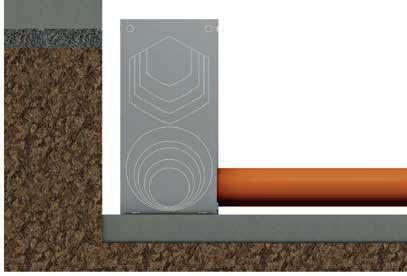
Having removed appropriate cut-out sections:


• Locate the plastic seating profiles affixed to the inside of each box. These profiles create a seating for the adjoining Slotdrain
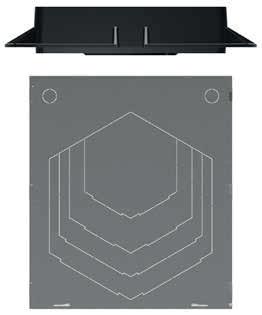



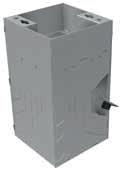
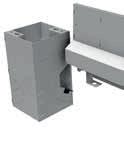
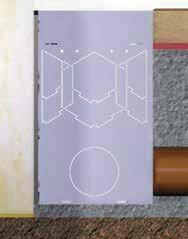
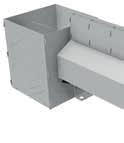
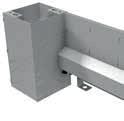




The spigot (male) end of the first channel should then be lowered onto the seating profiles, and set flush against the side of the box. The joint should be sealed with flexible sealant or construction sealing tape to prevent the ingress of concrete.


N.B. Covers and gratings are locked into place. Should removal be necessary, please ensure when replacing the cover/grating that the locking bolts are replaced.
Boxes must be backfilled with cover in place to help prevent distortion.
The void surrounding the box should be filled with concrete Grade 32/40. The concrete should be vibrated during pouring to ensure no voids exist around the box.
The level of the concrete fill around the the Gatic boxes is dependent on the surface finish of the installation.


Gatic Slotdrain channels can be connected to concrete chambers, which may be constructed from concrete on site, or supplied to site as pre-cast units.
The contractor should decide whether the channel units are installed first, with the concrete chamber formed around the ‘Chamber Connector’, or whether the concrete chamber should be formed first, with the channel installed after this.
If the latter option is chosen, then a void should be left in the wall of the concrete chamber, to accept the ‘Chamber Connector’ at a later time. This allows for greater flexibility when installing the channel.

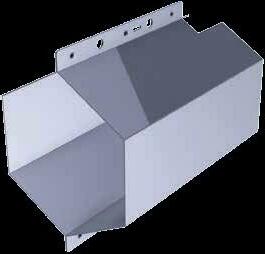
‘Chamber Connectors’ should be used. Available to suit all channel sizes, these provide a seamless connection through the concrete wall of the chamber.
The Flow Regulator should be fitted immediately after the Slotdrain channel has been connected to the silt box. Ensure that the semi-circular shaped orifice is at the bottom. At the position of the fixing holes either side of the wall plate, drill through the wall of the silt box and fix the unit with 2 x M12 concrete anchors or suitable bolts with a wing nut on the reverse side. Tape over any exposed section of thread on the bolt prior to backfilling with concrete. This will enable cleaner and quicker removal of the flow regulator for future maintenance.
The Flow Regulator should be fitted immediately after the Slotdrain channel has been connected to the silt box. Ensure that the semi-circular shaped orifice is at the bottom. At the position of the fixing holes either side of the wall plate, drill into the wall of the catchpit and fix the unit with 2 x M12 bolts. The fixings used should facilitate future removal of the flow regulator for maintenance.


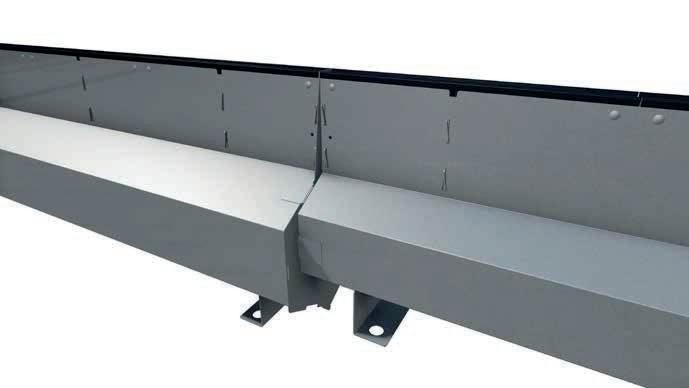
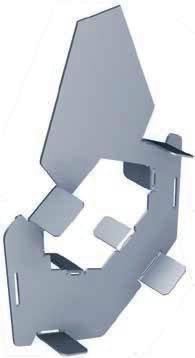

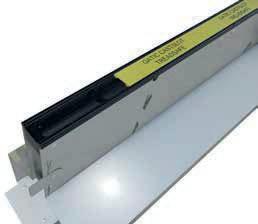

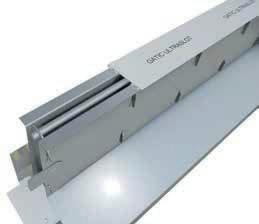
Channel units are connected with a simple ‘butt’ connection (pushconnection); no additional fixings are required. Units are fitted with ‘connection collars’ at one end, which help locate and align channels during installation.
Successive channel units should be pushed into these connection collars until a tight connection is achieved between channel sections.


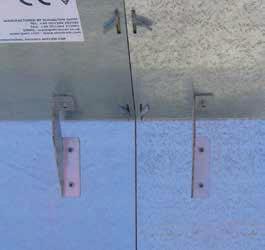
With Gatic Slotdrain, very precise connections can be achieved, improving the quality and finish of the installation, and reducing the risk of damage to channel units (no raised channel sections). If required, units can be moved together gently with a rubber ‘paving’ hammer.
Larger units are fitted with ‘Location Plates’, riveted to the inner walls of the channel (socket end). These also ensure accurate connection and location of channels when connected, and prevent the channel body from pinching inwards, during the main concrete pour.
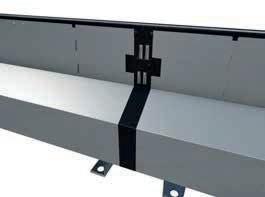
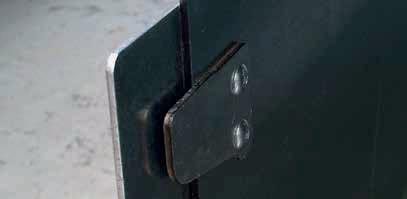
It is recommended that all joints between channel units and where channels meet Gatic boxes are taped prior to pouring the concrete surround. This is to prevent the ingress of concrete residue into the channel system.

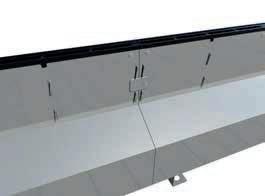
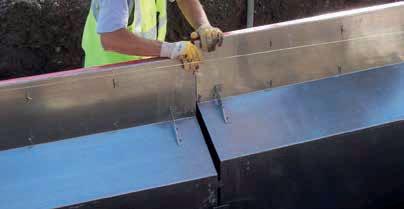
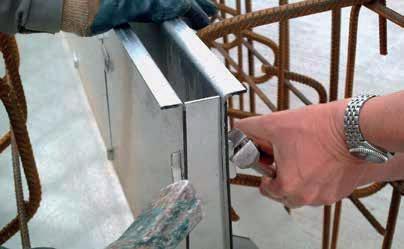
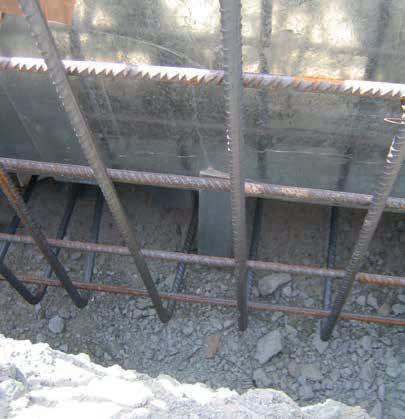
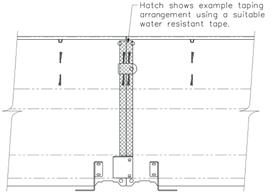
Gatic’s recommended steel reinforcing should be installed prior to concrete pouring, before channel units and Gatic boxes have been set in place and aligned.
Slight adjustment of ‘Throat Spacer Tags’ may be required to ensure a tight connection.
For concrete pavement and other rigid surface installations, expansion joints should be installed between the channel concrete surround and the adjacent pavement. The position of movement joints should be considered on a project-byproject basis by the project engineer to ensure that the maximum lengths of concrete are not exceeded and that movement joints are not installed at weak locations within the system.
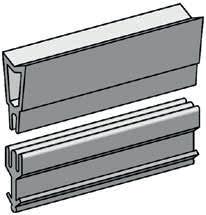
Where Gatic boxes are installed, an expansion joint should be fitted around the outside of these units, between the concrete surround, around the frame and the adjacent pavement.
Crack inducers should be laid at element joints.


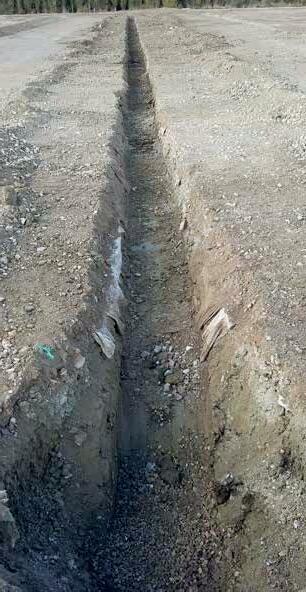
Site condition should be taken into account by project engineers.
These should be laid either side of the channel at 3m intervals (across the concrete surround). This detail is required for all channel systems installed in a concrete pavement. Crack inducers should not be laid at element joints as this may result in weakness of the structural surround.
Crack Control Joints can be formed in a variety of ways, including:
• Use standard expansion joint material
• Purpose made two-part plastic Crack
• Concrete surround can be cut with a disc cutting tool after the concrete has cured
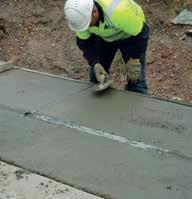
We would recommend the use of a Two-Part Top-Type Crack Inducer similar to the image right. These are pushed into the concrete surface during the pouring and smoothing phase, and the top section is removed after curing to leave a sealant void.


Note: For indicative purposes only
The ‘Formwork Method’ of installation is used if adjacent pavements are not yet in place, often when Gatic Slotdrain is to be installed in a new development.
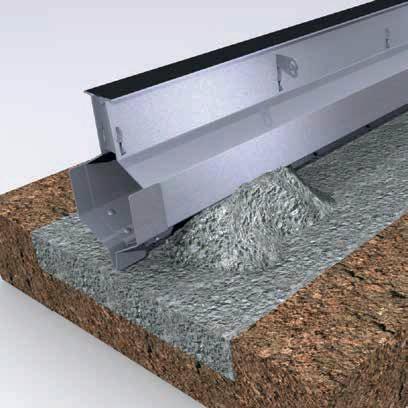
If the Gatic Slotdrain system and concrete surround is to be installed into an existing pavement area, it may be beneficial to use the ‘Suspended Method’ of installation.
Gatic recommends a solid concrete base is laid to provide a level and solid base on which to set the channel units.

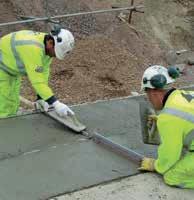
Once the base has cured, channel units and boxes are set in place and aligned on the concrete base.
Throat Protection Strip/Tape should be fitted around the channel at this point. A small amount of concrete may be applied around the ‘Channel Feet’ to prevent movement.




The trench should be wide enough to allow adequate working room, and the installation of steel reinforcing (if required). The minimum trench widths and installation drawings are shown on page 6.
Prepare two metal support bars and hook bolts for each Slotdrain channel (further information regarding the accessories required is available from Gatic).
Ensure the top edge of the channel is set below the adjacent pavement surface, in accordance with Gatic’s recommendations.
To avoid floatation, channel units should be restrained as necessary, with additional weight applied to the top of the channel.
Pour a C32/40 wet mix in two separate pours, with the first pour being placed to a depth of 20mm below the underside of the Slotdrain body. The second pour should ideally be placed within 3 days of the first pour, following cleaning off of the laitance left on the top of the concrete from the first pour.
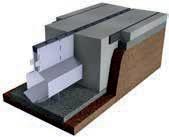
If an asphalt surface is required, base material and asphalt layers can then be laid to the edge of the concrete surround or CastSlot channel. A small manual rolling machine should be used to compact the asphalt at the outer edge of the channel concrete surround, to avoid damage to the concrete edge.



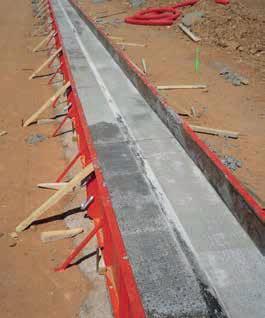
A formwork system is then erected on either side of the channel units. Timber props may be fitted between the throat section of the channel and the formwork inner wall, to maintain the horizontal position and straight alignment of channel units.

There are two requirements that must be fulfilled for forming a successful construction joint: the surface must be free from laitance (it is important to remove laitance - because of its high water content it is weak and porous, and will stop a strong watertight joint from being made with fresh concrete) and it should have an exposed aggregate finish.
Secondly the fresh concrete must be placed and compacted so that it bonds properly to the prepared surface of the previously laid concrete. Surface preparation (usually undertaken 1-2 hours after pouring) and placing of the second pour within 3 days of the first pour ensures a good bond between the two layers. A properly placed and compacted wet mix of this grade ensures a structurally sound, homogenous concrete.
Whilst still wet, apply the specified surface finish for the concrete. The specified cross-fall and surface finish should be applied in accordance with the drawings provided.
Two-part plastic ‘Crack Control Joints’ can then be applied.
When the concrete has cured, the formwork system is dismantled, leaving the channel and concrete surround in place.
Compaction machinery should not be allowed to pass over the channel or channel concrete surround. Machines should be directed along each side of the channel concrete surround, running parallel to the concrete edge. In order to prevent upward movement of channels when pouring concrete, units will require weights placed on top of the channels. To control the pressure exerted on channel walls during concrete pours, when steel reinforcing is used in the channel concrete surround, we recommend that the concrete is poured in two phases. This decision should be taken by the project structural engineer, and is subject to their approval. Larger units can be braced across the channel body prior to concrete pours if deemed necessary.
Expansion material can then be attached to the concrete surround, and the adjacent concrete pavements can be laid up to the concrete surround. When the concrete has cured, the formwork system is dismantled, leaving the channel and concrete surround in place.
The adjacent pavements can then be laid up to the concrete surround and the desired pavement finish added.
The ‘Suspended Method’ of installation is used if the adjacent concrete pavements are already in place, often when a Slotdrain system is installed into an existing pavement area.
If the Gatic Slotdrain system and channel concrete surround is required to be installed first; with the pavement installed afterwards, then the ‘Formwork Method’ of installation should be used.

Safely lower each channel into the prepared trench using appropriate lifting equipment. If reinforcing is required it should be placed and prepared in the trench before the Slotdrain is positioned and aligned.
Timber props may be fitted between the throat section of the channel and the trench inner wall, to maintain the horizontal position and straight alignment of channel.
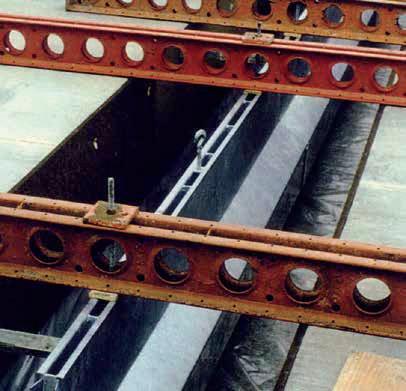
Longitudinal expansion joints should be fitted at this stage; these can be held in place by the timber props.
Throat Protection Strip/Tape should be fitted at this stage to prevent ingress of concrete whilst pouring.


To avoid floatation as necessary, channel units should be restrained, with additional weight applied to the top of the channel.
The trench should be wide enough to allow adequate working room, and the installation of steel reinforcing (if required). The minimum trench widths and installation drawings are shown on page 6.
Prepare two metal support bars and hook bolts for each Slotdrain channel (further information regarding the accessories required is available from Gatic).
To ensure the top edge of the channel is set below the adjacent pavement surface, in accordance with Gatic’s recommendations.
Pour a C32/40 wet mix in two separate pours, with the first pour being placed to a depth of 20mm below the underside of the Slotdrain body. The second pour should ideally be placed within 3 days of the first pour, following cleaning off the laitance left on the top of the concrete from the first pour.
In order to prevent upward movement of channels when pouring concrete, units will require weights placed on top of the channels. To control the pressure exerted on channel walls during concrete pours, when steel reinforcing is used in the channel concrete surround, we recommend that the concrete is poured in two phases. This decision should be taken by the project structural engineer, and is subject to their approval. Larger units can be braced across the channel body prior to concrete pours if deemed necessary.
There are two requirements that must be fulfilled for a forming a successful construction joint: the surface must be free from laitance (it is important to remove laitance - because of its high water content it is weak and porous, and will stop a strong watertight joint from being made with fresh concrete) and should have an exposed aggregate finish.
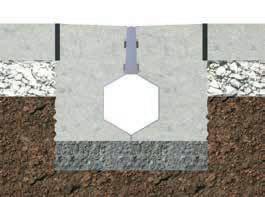
There are a number of considerations to take into account regarding expansion and the installation of Gatic Slotdrain.
The coefficient of thermal expansion for a material is a measure of how much that material will expand for each change in temperature of 1 degree. A table of commonly used materials and their expansion coefficients is set out below:
MaterialExpansion
Please refer to the installation drawings and page 18 for details regarding the position of expansion joints.
‘Longitudinal’ and ‘Crack Control Joints’ (Crack Inducers/Shrinkage Joints) may not be required for installations where asphalt or paving units (with sand filled joints) are the surface finish. This is because these surfaces are ‘flexible’ and will move naturally when subject to temperature changes.
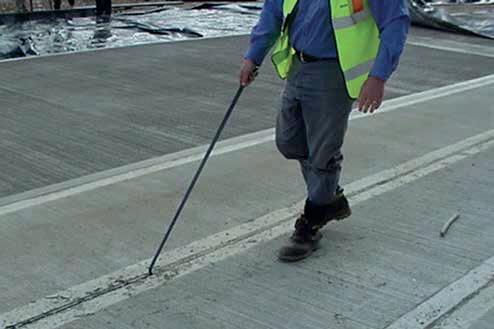

Expansion joints may only need to be considered when the surfaces are rigid such as concrete pavements and paving units with cement joints. In such cases, expansion joints are required to protect the channel from lateral forces (exerted by expansion of the adjacent pavement), and to avoid cracking within the concrete surround due to shrinkage.
We do not recommend that open expansion joints (left unfilled, with no expansion material) are used around Gatic Slotdrain channels. These can become filled with silt and debris over time, and then become ineffective.
The type, material and thickness of expansion joints used to provide these construction joints should ultimately be the choice of the project engineer, as they are more familiar with site conditions and characteristics. Most products should be readily available (or easily sourced). The performance of the expansion joint product and material within the local environment should be assessed.
Once the installation is complete, Throat Protection Tape or Strip should be removed, and the channel system should be flushed clean with water.
*Steel has a similar expansion rate to concrete, so Gatic Slotdrain will expand and contract at a similar rate to the channel concrete surround, thereby minimising stresses caused by differential rates of expansion.


The thickness of the expansion joint material used will depend on the anticipated rate of expansion, which is a factor of the temperature differential in the local environment, the type of concrete and aggregate used, the thickness of the concrete pavement, and the location and spacing of pavement expansion joints etc. There are many factors involved which may have an influence on the rate of movement of the concrete pavements adjacent to the channel. The expansion material used should be thick enough to cope with the anticipated movement and pressure exerted by the adjacent concrete pavements.
Common expansion materials used are fibre-board and ‘Semi Cross Linked Polyethylene (Large Cell) Expansion Material’. We would not recommend that polystyrene is used, since this material does not regain its original dimensions once compressed.
The minimum cross fall towards the channel central slot is shown on the drawings provided.
The surface material to be applied should be levelled appropriately. When using asphalt, this should be applied evenly around the channel throat area and levelled with a rake. A small rolling machine should then be used to compact the asphalt around the channel. It is important to note that compaction machinery should not be allowed to pass over the channel slot and throat area during rolling as this can damage the product. Machinery should be carefully directed along each side of the throat running parallel to the channel.
When installing a channel in adjacent paving materials, set the first block adjacent to the Slotdrain channel on a 15mm deep layer of polymermodified mortar, and surrounding materials in accordance with the paving supplier’s instructions.
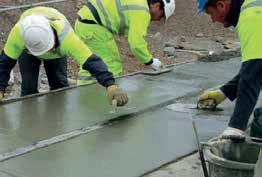
In some projects there may be a requirement to install the Gatic Slotdrain system to follow a given radius, for example around the perimeter of a taxiway on an airport project, or following the curve of a landscape feature.
Gatic Slotdrain channel units are available in straight lengths of 500mm, 1m or 3m.
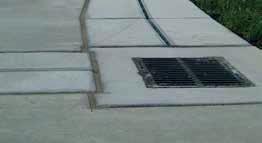

These can be formed using standard units, with each consecutive channel unit positioned at a slight angle in relation to the previous channel.


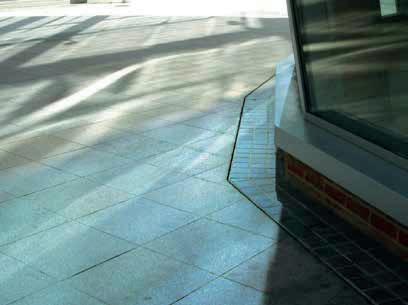
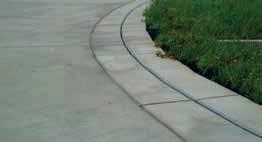
Please refer to the tables on pages 27, 28 and 29. for the achievable radius for standard channels in the range.
When positioning channel units, a gap is formed between channels on the outside edge.
All gaps between the channel joints, on both sides of the channel, should be sealed with a strong construction tape prior to concreting.
503m189.8m94.9m63.2m47.4m37.9m31.6m27.0m23.6m21.0m18.9m
501m63.3m31.6m21.1m15.8m12.6m10.5m9.0m7.9m7.0m6.3m
50500mm31.6m15.8m10.5m7.9m6.3m5.3m4.5m3.9m3.5m3.1m
753m265.2m132.6m88.4m66.3m53.0m44.1m37.8m33.1m29.4m26.4m
751m88.4m44.2m29.5m22.1m17.7m14.7m12.6m11.0m9.8m8.8m
75500mm44.2m22.1m14.7m11.0m8.8m7.4m6.3m5.5m4.9m4.4m
1153m376.9m188.4m125.6m94.2m75.3m62.8m53.8m47.1m41.8m37.6m
1151m125.6m62.8m41.9m31.4m25.1m20.9m17.9m15.7m13.9m12.5m
115500mm62.8m31.4m20.9m15.7m12.6m10.5m9.0m7.8m7.0m6.3m
503m189.9m95.0m63.3m47.5m38.0m31.7m27.1m23.7m21.1m19.0m 501m63.3m31.7m21.1m15.9m12.7m10.6m9.1m8.0m7.1m6.4m
50500mm31.7m15.9m10.6m8.0m6.4m5.3m4.6m4.0m3.6m3.2m
753m265.2m132.7m88.5m66.4m53.1m44.3m37.9m33.2m29.5m26.6m 751m88.5m44.3m29.5m22.2m17.8m14.8m12.7m11.1m9.9m8.9m
75500mm44.3m22.2m14.8m11.1m8.9m7.5m6.4m5.6m5.0m4.5m
1153m377.0m188.6m125.7m94.3m75.5m63.0m53.9m47.2m42.0m37.8m
1151m125.8m62.9m42.0m31.5m25.2m21.1m18.1m15.8m14.1m12.7m
115500mm62.9m31.5m21.1m15.8m12.7m10.6m9.1m8.0m7.1m6.4m
1003m320.9m160.5m107.0m80.3m64.2m53.5m45.9m40.2m35.7m32.1m
1001m107.0m53.6m35.7m26.8m21.5m17.9m15.4m13.5m12.0m10.8m
100500mm53.6m26.8m17.9m13.5m10.8m9.0m7.7m6.8m6.0m5.4m


1503m471.6m235.9m157.3m118.0m94.4m78.7m67.5m59.1m52.5m47.3m
1501m157.3m78.7m52.5m39.4m31.6m26.3m22.6m19.8m17.6m15.9m
150500mm78.7m39.4m26.3m19.8m15.9m13.3m11.4m10.0m8.9m8.0m
2253m695.1m347.7m231.9m173.9m139.2m116.0m99.5m87.1m77.4m69.7m
2251m231.9m116.0m77.4m58.1m46.6m38.8m33.3m29.2m26.0m23.4m
225500mm116.0m58.1m38.8m29.2m23.4m19.5m16.8m14.7m13.1m11.8m
3003m918.6m459.5m306.4m229.9m184.0m153.4m131.5m115.1m102.3m92.1m
3001m306.4m153.4m102.3m76.8m61.5m51.3m44.0m38.6m34.3m30.9m
300500mm153.4m76.8m51.3m38.6m30.9m25.8m22.2m19.4m17.3m15.6m
3503m1069.4m534.9m356.7m267.6m214.2m178.5m153.1m134.0m119.1m107.2m
3501m356.7m178.5m119.1m89.4m71.6m59.7m51.3m44.9m39.9m36.0m
350500mm178.5m89.4m59.7m44.9m36.0m30.1m25.8m22.6m20.2m18.2m
4003m1220.9m610.7m407.2m305.5m244.5m203.8m174.8m153.0m136.0m122.4m
4001m407.2m203.8m136.0m102.1m81.8m68.2m58.5m51.3m45.6m41.1m
400500mm203.8m102.1m68.2m50.9m41.1m34.3m29.5m25.8m23.0m20.7m
5003m1522.4m761.4m507.8m381.0m304.9m254.2m217.9m190.7m169.6m152.7m
5001m507.8m254.2m169.6m127.3m102.0m85.1m73.0m63.9m56.9m50.7m
500500mm254.2m127.3m85.1m63.9m51.2m42.8m36.7m32.2m28.7m25.9m
6003m1816.5m908.5m605.9m454.6m363.8m303.2m260.0m227.6m202.4m182.2m
6001m605.9m303.3m202.4m151.9m121.7m101.5m87.1m76.3m67.9m61.1m
600500mm303.3m151.3m101.5m76.6m61.1m51.0m43.8m38.4m34.2m30.9m
1003m320.8m160.4m106.9m80.2m64.1m53.4m45.8m40.0m35.6m32.0m
1001m106.9m53.5m35.6m26.7m21.4m17.8m15.3m13.3m11.9m10.7m
100500mm53.5m26.7m17.8m13.4m10.7m8.9m7.6m6.7m5.9m5.3m
1503m471.5m235.7m157.1m117.8m94.3m78.5m67.3m58.9m52.3m47.1m
1501m157.2m78.6m52.4m39.3m31.4m26.2m22.4m19.6m17.4m15.7m
150500mm78.6m39.3m26.2m19.6m15.7m13.1m11.2m9.8m8.7m7.9m
2253m694.9m347.4m231.6m173.7m139.0m115.8m99.2m86.8m77.2m69.5m
2251m231.6m115.8m77.2m57.9m46.3m38.6m33.1m28.9m25.7m23.2m
225500mm115.8m57.9m38.6m29.0m23.2m19.3m16.5m14.5m12.9m11.6m
3003m918.3m459.2m306.1m229.6m183.7m153.0m131.2m114.8m102.0m91.8m
3001m306.1m153.1m102.0m76.5m61.2m51.0m43.7m38.3m34.0m30.6m
300500mm153.1m76.5m51.0m38.3m30.6m25.5m21.9m19.1m17.0m15.3m
3503m1069.0m534.5m356.3m267.2m213.8m178.2m152.7m133.6m118.8m106.9m
3501m356.3m178.2m118.8m89.1m71.3m59.4m50.9m44.5m39.6m35.6m
350500mm178.2m89.1m59.4m44.5m35.6m29.7m25.5m22.3m19.8m17.8m
4003m1220.9m610.3m406.8m305.1m244.1m203.4m174.3m152.5m135.6m122.0m
4001m407.2m203.4m135.6m101.7m81.4m67.8m58.1m50.9m45.2m40.7m
400500mm203.8m101.7m67.8m51.3m40.7m33.9m29.1m25.4m22.6m20.3m
5003m1522.4m760.9m507.3m380.5m304.4m253.6m217.4m190.2m169.1m152.2m
5001m507.8m253.6m169.1m126.8m101.5m84.5m72.5m63.4m56.4m51.2m
500500mm254.2m126.8m84.5m63.4m50.7m42.3m36.2m31.7m28.2m25.4m
6003m1815.9m907.9m605.3m454.0m363.2m302.6m259.4m227.0m201.8m181.6m
6001m605.9m302.6m201.8m151.3m121.1m100.9m86.5m75.7m67.3m60.5m
600500mm303.3m151.9m100.9m75.7m60.5m50.4m43.2m37.8m33.6m30.3m
Gatic Slotdrain channel system will require access units to be placed in strategic locations along the channel run, to provide access into the system for cleaning and maintenance.
The position of access units should be determined by the client and project engineer, taking into account the maintenance equipment that will be used.
Specifiers may consider the following:
• Access units should be placed at the start of every channel run.
• Access units should be placed at every corner, or at the point where the channel changes direction.
• 100-350mm Wide Channels: Mid-run access units should be placed every 30-50m.
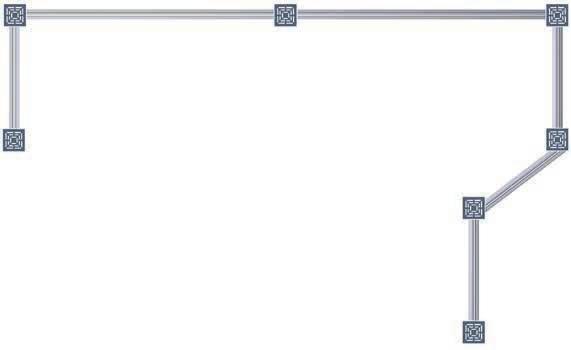
• 400-600mm Wide Channels: Mid-run access units should be placed every 75-100m.
Gatic Slotdrain channels should be inspected regularly to ensure that the system continues to operate effectively, and is free from damage and blockage by debris or solid objects.
The system should be cleaned at least once a year, and incorporated into a planned maintenance schedule. The frequency of inspection and maintenance depends on the local environment and conditions.
An access unit should always be placed in corner positions
An access unit is always positioned at the start of channel
These are guidelines only – each project should be individually assessed regarding placement of access units.
• For short channel runs of 10m long or less, channel end-caps may be sufficient at the start of the channel run, as cleaning can be carried out from the catch pit end.
5
Further advice and information is available from Gatic regarding the positioning of access units.
Channel units can be cleaned through the use of a high-pressure hose. This can be fed into the channel system through access units strategically placed along the channel run (see p30, ‘Positioning Access Units’).
The throat section of channel units should be kept clear at all times to ensure uninterrupted flow of water into the drainage channel. Any debris within the throat should be removed.
Catch pit can be used as an access point for cleaning and rodding
Midpoint access unit (in line)
Access units should always be placed whenever a channel changes direction
An access unit is always positioned at the start of channel
The seating areas for covers and grates should be cleaned before they are replaced. The covers and grates should be locked into position to prevent these being removed, stolen or dislodged by traffic. Locking bolts should be replaced and sufficiently tightened, taking care that the bolt heads do not stand above the top surface of the cover or grate. If grates/covers are allowed to move within their frame, this may cause damage to the frame or seating.



‘Risk Assessment’ information is available from Gatic on request.
Gatic offers a comprehensive design service, which is free of charge. After submission of the relevant project information to our technical team, we can provide detailed channel layout drawings (AutoCAD), hydraulic calculation datasheets, system part schedules and product installation drawings. Our team can also check your design and provide a detailed cost estimating service.
To speak with our technical department, forward an enquiry, or to make contact with a sales engineer, please contact Gatic using the details below:

Tel: +44 (0) 1304 203 545
Email: info@gatic.com Website: www.gatic.com



Please visit the ‘Case Studies’ section of the website for details of projects where Gatic Slotdrain has been used. These highlight the benefits and savings that can be achieved by using the system.
Our website is ultra user-friendly and offers full details of our Slotdrain surface water drainage systems, channel drainage and linear drainage. This includes features and benefits, sizes and load categories, as well as design service and contact information. The website also contains dedicated Access Covers and StreetWise sections.
A comprehensive brochure on Gatic’s extensive range of surface water drainage: Slotdrain, Filcoten® and ProSlot, as well as Harmer’s SML below ground drainage for the complete solutions package. The brochure includes detailed information on load classes, product applications, technical tables, 3D render images and technical support, plus Gatic’s free Drainage Design Software and its association with MicroDrainage software.
This interactive software allows you to design your own drainage system using the same programme as our in-house design engineers. For a USB containing this free software, simply register your details with us. You can do this on the MyGatic section of our website, or by emailing / phoning us.

Our Gatic Access Covers Product Selector software is now available and can be sent to you on a USB for free. Simply register your details with us on the MyGatic section of our website, or by emailing / phoning us.




